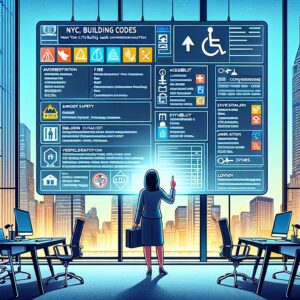Navigating the Concrete Jungle: Your Guide to Building Codes in New York City (and Beyond)
New York City, a vibrant tapestry woven from diverse neighborhoods, each pulsating with its own unique rhythm. From the towering canyons of Manhattan to the charming brownstones of Brooklyn, the city hums with an energy that’s both exhilarating and daunting. But for aspiring renovators and ambitious homeowners, this urban jungle holds a hidden labyrinth – the enigmatic realm of building codes.
These intricate regulations, often shrouded in technical jargon and bureaucratic red tape, can feel like a cryptic language spoken by faceless authorities. Fear not, intrepid urban explorers! This guide is your decoder ring, a Rosetta Stone to unlock the secrets of New York City’s building code landscape. We’ll navigate the winding paths, demystifying the jargon, and equipping you with the knowledge to confidently tackle your next renovation project, whether it’s a cozy Brooklyn kitchen makeover or a Staten Island backyard oasis.
So, shed your fear of the permit process and ditch the anxiety of code compliance. This guide, tailored specifically for the vibrant boroughs of Brooklyn, Staten Island, Queens, Long Island, and NYC proper, will be your trusty compass as you carve your own urban masterpiece within the concrete jungle. With step-by-step instructions, practical resources, and a dash of architectural adventure, you’ll be navigating the building code labyrinth like a seasoned New Yorker in no time.
Ready to unleash your inner urban architect and transform your New York nook into a space that reflects your unique style? Grab your metaphorical hard hat, because it’s time to embark on a thrilling journey through the concrete jungle, armed with the knowledge to build your dream, brick by brick, and code by code.

Step 1: Mapping the Maze: Demystifying Building Code Jurisdictions in New York City
Imagine New York City as a labyrinthine metropolis, each borough a distinct district with its own architectural language and regulatory dialect. Unraveling the mysteries of building codes can feel like deciphering an ancient map, its lines blurring and symbols cryptic. But fear not, intrepid explorer, for Step 1 equips you with the cartographer’s tools to navigate this concrete jungle with confidence.
Charting Your Borough:
- Brooklyn: Brooklyn, the borough of brownstones and artistic spirit, dances to the tune of the Department of Buildings (DOB) and the city’s Building Code (BC). While the BC serves as the guiding melody, Brooklyn adds its own local variations, like specific zoning regulations or historical preservation requirements. Think of it as a jazz riff on the main theme. Explore the Brooklyn Building Code and zoning regulations here: https://www.nyc.gov/site/buildings/codes/nyc-code.page.
- Staten Island: Across the harbor, Staten Island, the borough of verdant landscapes and family vibes, shares the same musical score as Brooklyn. The DOB and BC set the tempo, but Staten Island adds its own unique verses, like stricter guidelines for waterfront construction or specific codes for single-family homes. Dive into the Staten Island Building Code and zoning regulations here: https://www.nyc.gov/site/buildings/codes/nyc-code.page.
- Queens & Long Island: Venturing further, Queens and Long Island, each with their own distinct boroughs and personalities, have their own building code orchestras. Queens, the melting pot of cultures, conducts a symphony of regulations specific to its diverse neighborhoods, while Long Island, with its patchwork of counties, plays a concerto of codes that vary by location. Find your specific Queen’s Building Code and zoning regulations here: https://www.nyc.gov/site/buildings/index.page. Long Island codes vary by county, so visit the website of your specific county’s building department for details.
- NYC Proper: Manhattan, the Bronx, and parts of Brooklyn and Queens, form the core of the city’s building code symphony. The DOB leads the ensemble, conducting the BC with a firm hand, ensuring harmony and safety throughout the urban landscape. Access the NYC Building Code and navigate regulations for specific areas here: https://www.nyc.gov/site/buildings/codes/nyc-code.page.

Technological Innovation in Building Code Consultation
Finding Your Tune:
Now that you know the orchestra, it’s time to identify your specific melody. Is your project a small bathroom renovation in Brooklyn’s trendy Williamsburg, or a major extension in Staten Island’s peaceful suburbs? Pinpointing your location within the borough and the nature of your project will help you tune into the relevant regulations.
Online Resources:
Technology is your friend in this concrete jungle. Each borough’s Department of Buildings website holds a treasure trove of information, from downloadable code documents to interactive maps highlighting zoning regulations. Don’t hesitate to dive in and explore!
Bonus Tip: If you’re feeling overwhelmed by the sheer volume of information, remember, the DOB also offers helpful phone consultations. Think of it as a hotline to the conductor, ready to answer your questions and guide you through the musicality of building codes. Find contact information for the DOB’s phone consultations here: https://www.nyc.gov/site/buildings/dob/contact-us.page.
Step 2: Decoding the Renovation Symphony: Understanding Project Scope and Permitting Needs
With the architectural map of your borough unfolding before you, Step 2 invites you to delve deeper into the specifics of your renovation project. This is where the technical jargon starts to waltz with your creative vision, and navigating the permit process becomes a crucial melody in the symphony of your urban transformation.
Unpacking the Project Scope:
Before diving into the permit pool, take a moment to assess the nature of your renovation. Is it a minor refresh, like swapping out your kitchen faucet or painting your living room in a bold new hue? Or are you embarking on a major composition, like adding a sunroom or completely reconfiguring your bathroom layout?
- Minor Alterations: For minor cosmetic changes that don’t affect structural elements or plumbing systems, you might be in luck! Many minor alterations fall under the category of “ordinary work” and may not require permits. However, always check with your borough’s Department of Buildings (DOB) to confirm, as specific regulations can vary. You can find resources and information on ordinary work through the DOB website: https://www.nyc.gov/site/buildings/property-or-business-owner/do-i-need-a-permit.page: https://www.nyc.gov/site/buildings/property-or-business-owner/do-i-need-a-permit.page.
- Major Renovations: For more substantial projects that involve structural changes, plumbing modifications, or electrical upgrades, obtaining the right permits is essential. This ensures your renovation adheres to safety standards and maintains the structural integrity of your home. Depending on the complexity of your project, you may require various permits, such as:
- Alteration Type 1 (ALT1): For minor structural changes like replacing windows or doors.
- Alteration Type 2 (ALT2): For more significant structural alterations like adding a deck or expanding a room.
- Mechanical and Plumbing Permits: For modifications to your plumbing or electrical systems.

Building the Future: Compliance with Codes at NYC Construction Sites
Navigating the Permit Maze:
Once you’ve identified the type of permits you need, the next step is to gather the necessary documentation and submit an application to your borough’s DOB. The specific requirements can vary, but generally, you’ll need:
- Completed permit application forms: Downloadable forms can be found on the DOB website.
- Detailed plans and drawings: These should be prepared by a licensed architect or engineer, clearly outlining the scope of your project.
- Fees: Permit fees vary depending on the type and complexity of your project.
Bonus Tip: Feeling overwhelmed by the paperwork? Don’t hesitate to seek help! Many architects, engineers, and contractors offer permit application assistance services.
Remember, obtaining the necessary permits is an investment in your safety and the longevity of your home. It’s always better to err on the side of caution and ensure your renovation adheres to the city’s regulations.
With Step 2 mastered, you’ve transformed from a curious explorer to a permit-savvy navigator. Armed with the knowledge of your project scope and permit requirements, you’re now ready to confidently waltz through the permit process, paving the way for your dream renovation to become a reality.
Step 3: Conquering the Permit Peaks: A Guide to Navigating the New York City Permit Process
With your project scope defined and the permit symphony playing in your head, Step 3 invites you to climb the permit peaks of New York City. This is where the rubber meets the road, where your knowledge of codes and regulations translates into concrete action. Fear not, intrepid renovator, for this step equips you with the tools to scale the bureaucratic mountains and emerge victorious with your permits in hand.
Scaling the Permit Summit:
The first step on your permit journey is identifying the right path. Each borough in New York City has its own Department of Buildings (DOB) and website, your entry points into the permit landscape. Here’s where to start:
- Brooklyn: https://www.nyc.gov/site/buildings/index.page: https://www.nyc.gov/site/buildings/index.page
- Staten Island: https://www.nyc.gov/site/buildings/index.page: https://www.nyc.gov/site/buildings/index.page
- Queens: https://www.nyc.gov/site/buildings/index.page: https://www.nyc.gov/site/buildings/index.page
- Long Island: Regulations vary by county, so visit your specific county’s building department website for details.
- NYC Proper: https://www.nyc.gov/site/buildings/index.page: https://www.nyc.gov/site/buildings/index.page
Gathering Your Gear:
Once you’ve identified your path, it’s time to gather your permit essentials. Think of it as packing for an architectural expedition:
- Completed Permit Application Forms: Downloadable forms are available on the DOB website specific to your project type and borough.
- Detailed Plans and Drawings: These blueprints, prepared by a licensed architect or engineer, are your visual roadmap, clearly outlining the scope and details of your renovation.
- Fees: Don’t forget the permit fee! Fees vary depending on the complexity and type of permit you need. Check the DOB website for specific details.
- Additional Documentation: Depending on your project, you may need additional documents like property surveys, structural analysis reports, or environmental impact assessments. Consult the DOB website or contact them directly for specific requirements.

Meticulous Planning: An Architect’s Workspace in NYC
Climbing the Permit Ladder:
With your backpack full of essentials, it’s time to ascend the permit ladder. Here are the key steps:
- Submit Your Application: Submit your completed application forms, plans, and fees to your borough’s DOB. You can submit online, via mail, or in person.
- Plan Review: Expert eyes at the DOB will review your application and plans to ensure they comply with building codes and zoning regulations. This may involve revisions and clarifications.
- Permit Issuance: Once your application is approved, you’ll receive your official permit! This green light is your passport to start your renovation journey.
- Inspections: Throughout your project, the DOB may conduct inspections to ensure your work adheres to the approved plans and safety regulations.
Bonus Tip: Feeling lost in the permit labyrinth? The DOB offers helpful resources and guidance, including online tutorials, FAQs, and even phone consultations. Don’t hesitate to reach out for assistance!
Remember, conquering the permit peaks requires patience, persistence, and a willingness to navigate complex processes. But with the knowledge and tools provided in this step, you’ll be scaling those peaks with confidence, one permit at a time.
Step 4: Partnering with the Pros: Navigating the Renovation Landscape with Trusted Professionals
With your permit summit conquered and the blueprints for your dream space in hand, Step 4 invites you to embark on a collaborative journey with the architects, engineers, and contractors who will help your vision materialize. This is where your DIY spirit meets expert guidance, transforming your renovation into a symphony of skilled hands and coordinated efforts.
Finding Your Architectural Orchestra:
Just as every orchestra needs a conductor, your renovation needs a skilled leader. Consider hiring a licensed architect or engineer, your renovation maestro, to guide the overall vision and ensure structural integrity. They can:
- Translate your dreams into concrete plans: Work with you to understand your vision, translate it into detailed blueprints, and ensure they comply with building codes.
- Navigate the permit maze: Assist with permit applications, answer technical questions, and liaise with the DOB on your behalf.
- Coordinate the construction symphony: Guide the selection of contractors, oversee the project timeline, and ensure quality control throughout the process.
Building Your Contractor Crew:
Once the architectural blueprint is established, it’s time to assemble your contractor crew. These skilled musicians will bring your vision to life, brick by brick, pipe by pipe. Consider factors like:
- Experience and specialization: Choose contractors with experience in your specific project type, whether it’s kitchen remodels, bathroom renovations, or historical preservation projects.
- Licensing and insurance: Ensure all contractors are licensed and carry proper insurance for your protection.
- Reputation and references: Check online reviews, get recommendations from friends, and contact previous clients to assess their work ethic and quality.
- Quotes and contracts: Obtain detailed quotes from multiple contractors and carefully review contracts before signing.
Harmonious Collaboration:
Remember, successful renovations are a collaborative effort. Communicate openly with your architect, engineer, and contractors throughout the process. Share your concerns, ask questions, and be a part of the decision-making process.
Bonus Tip: Don’t be afraid to negotiate! Get multiple quotes, compare prices, and be prepared to discuss your budget openly with potential contractors.
By finding the right team of professionals and fostering open communication, you can ensure your renovation symphony plays in perfect harmony, transforming your New York nook into your masterpiece.
Resources:
- American Institute of Architects (AIA): https://www.aia.org/
- National Society of Professional Engineers (NSPE): https://www.nspe.org/
- Better Business Bureau (BBB): https://www.bbb.org/
Remember: Building codes are the invisible conductors of the urban symphony, ensuring the safety and integrity of your home and the city as a whole. By respecting these regulations, navigating the permit process, and partnering with skilled professionals like those found on RenovationServices.com, you can transform your New York nook into a masterpiece that resonates with your unique style and echoes with the city’s vibrant rhythm.
Bonus Resources:
- NYC Department of Buildings (DOB): https://www.nyc.gov/site/buildings/index.page
- Brooklyn Building Department: https://www.nyc.gov/site/buildings/index.page
- Queens Building Department: https://www.nyc.gov/site/buildings/index.page
- Long Island Building Departments (by county): https://www.nassaucountyny.gov/3482/Building-and-Zoning-Permits





